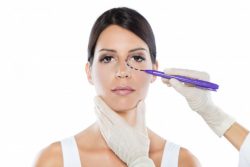 Everyone would like to have youthful-appearing eyes. Sometimes, no amount of moisturizers, eye creams or Botox injections can fully address saggy skin, hollows, and eyebags. These changes occur over time and are caused by changes in skin laxity and volume loss.
Everyone would like to have youthful-appearing eyes. Sometimes, no amount of moisturizers, eye creams or Botox injections can fully address saggy skin, hollows, and eyebags. These changes occur over time and are caused by changes in skin laxity and volume loss.
Blepharoplasty is the surgery used to modify the skin, muscle, and fats around the eyes. This is commonly used to correct defects and deformities of the eye and to aesthetically enhance its appearance. As early as the 10th century, eyelid surgery has been used to treat visual impairment caused by excess skin. The term “Blepharoplasty” was coined by Von Graefe in 1818 when he used this procedure to reconstruct the eyelids after they were left deformed from the excision of carcinoma. Since that time, a myriad of excellent and talented surgeons have written about and contributed to the evolution of the procedure to what it is today.
Cosmetically, eyelid surgery is used to address signs of aging such as drooping eyelids and eye bags. It entails excising excess skin and removing or repositioning fats around the eyes to obtain a more youthful appearance. Young patients may opt to do a blepharoplasty to enhance the appearance of their eyes (deep-setting). The procedure is also being done by Asians to produce a fold which they believe makes their eyes look more attractive. Medically, however, it may be used to address peripheral visual field defects caused by the sagging skin (Functional Blepharoplasty) and correction of uneven lids due to muscle weakness (Ptosis). This muscle weakness causes the affected eye to have a shallower but higher eye fold coupled with a smaller, sleepy-looking eye.
Although the procedure does not affect eyesight, patients who have excessive tearing, dryness, floaters or other visual issues are encouraged to seek clearance with an Ophthalmologist of their choice prior to scheduling their surgery. On the other hand, patients with overly puffy eyelids should be cleared medically to make sure they do not actually have an undiagnosed thyroid issue.
Preoperatively, aesthetic goals must be clearly defined. This will ensure that both the patient and the surgeon understand whether or not these goals are attainable and how it will affect the final appearance. Patient satisfaction will depend on how closely his/her goal was achieved. Each patient will have his or her own aesthetic goal, so despite the procedure being straightforward, it is important to take note of nuances between patients’ wants and desires.
The Blepharoplasty Procedure
The procedure itself is quite simple. It only takes about 30 minutes per eye and it is commonly done under local anesthesia. For the upper eyelid, the incision will be hidden in the eye fold itself while for the lower lid, the incision will be underneath the lash line. Some surgeons opt to place their incision for the eyebags inside the eye (Transconjunctival) so that there is no external scar. This practice is acceptable for those patients who do not have excess skin.
For the Upper Blepharoplasty, skin and muscle are excised. Three fat compartments are identified and removed. If the patient has Ptosis, the muscle is reinforced to make the eye even to the normal eye. For the Lower Blepharoplasty, a skin and muscle flap is developed. Three fat compartments are identified and removed or repositioned. The skin-muscle flap is redraped and any excess is removed before closure.
Care must be taken to ensure that not too much skin is excised. An overly zealous surgeon can remove too much in the hope of giving the patient a tighter look. Instead, patients end up having problems such as having a perpetually surprised look, difficulty closing the eyes completely and ectropion (downward sagging of the lower lids) which leads to dryness, itchiness and some degree of disfigurement.
What to Expect After Eyelid Surgery?
After the procedure, patients are sent home with antibiotics and pain relievers and are asked to refrain from strenuous activities. There is no need for bandages. Patients are simply advised to bring their sunglasses. Cold compress is applied on the first 2 days. Stitches are removed on the 4th day. Best results are expected by the 4th to 8th month after surgery.
Frequently Asked Questions
What is blepharoplasty?
Blepharoplasty is aesthetic correction of the eyelids: Enhancing the 1) upper eyelid folds (“deep setting” or lifting droopy lids) or eyebag removal from the lower eyelids.
Do I need to be asleep for the procedure?
This is a relatively easy surgery. It only takes the doctor about 30 minutes to do each eye. It may be done awake and under local anesthesia. If you are a little anxious, or are pairing your eye surgery with other surgeries, then it may be done under sedation. Regardless of which anesthetic used, you can go home on the same day.
Will I be able to see after the procedure?
Yes. The surgery is only skin deep. We will not be affecting your vision in any way. In terms of bandaging, you will only be wearing your favorite sunglasses. So your vision will not be obscured by either the surgery or bandages.
Will I need medication after the surgery?
Even if it is considered a clean case, you will still need to take antibiotics for 3 days for prophylaxis. You will also be sent home with a prescription for pain medication.
